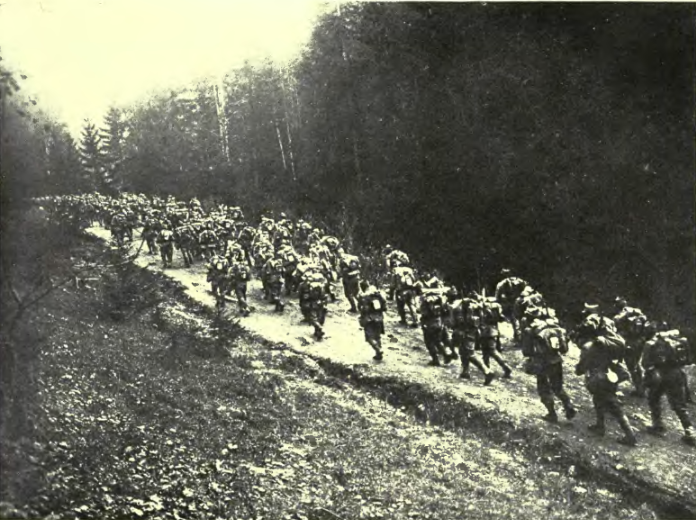For the planned counteroffensive of the Central Powers against Romania, Falkenhayn’s first target was the Romanian army corps that remained to the south of Sibiu, 20 to 25 kilometres away from the pass, 60 kilometres away from the Jiu army corps and 50 kilometres away from the Romanian Second Army. The only way out was through the pass, but the Romanians risked being outflanked by troops of the German Alpine Corps using the mountain passes. For three weeks, this army corps made no move, waiting for new orders. Commanded by General Ioan Popovici, the two infantry and cavalry brigade divisions, which had only 19 artillery batteries and 34 machine guns, did not pose a serious threat for the combined German and Austro-Hungarian forces. Information was sorely lacking, with the Romanians being basically unaware of the large number of enemy soldiers facing them down. When reconnaissance finally revealed the seriousness of the situation the commanders of the First Army Corps did not take steps to prepare for the coming attack.
The army corps that was stationed near Sibiu consisted of two German infantry divisions and a Hungarian infantry division, with 59 artillery batteries and 172 machine guns. Compared to the Romanian troops, which were relying for their defence of the flanks on the cover provided by the adjacent mountain range, the Germans had a mountain troop unit on the right flank and a cavalry unit on its left flank towards Făgăraș. Falkenhayn ordered his mountain troops to flank the Romanians and to hold the pass behind them, while the cavalry had to thwart any escape attempt to the east and to prevent any relief force from intervening.
On September 22, without being detected by the Romanian forces, the German mountain troops started their climb to the left of the Romanian defensive line, on a few, difficult to access passes, with only the weapons and ammunition that they could carry, discarding some of the heavier equipment along the way. The advance was eased because some of paths were already cleared by the Romanians not long before. On the evening of September 24, Romanian patrols encountered and opened fire on the Germans, and the next day Popovici sent troops to intercept them. Romanian command believed it was all just a diversion, so it did not pay too much attention to it. On September 26, the Germans occupied the Boiţa, Lunci and Câineni line, cut telephone wires and electric lines, blew up sections of the railroad track and blocked the road. The Romanians succeeded, after mortar attacks, to force the Germans to withdraw back towards the mountains, but they continued to pose a threat to the road and the traffic here.
On the same day, Falkenhayn ordered a counterattack on Romanian positions. It began with a powerful artillery barrage, followed by a succession of frontal assaults, repulsed by the Romanians, who also counterattacked, going up against German artillery and machine guns, but with no remarkable results. On September 25, the troops on the Jiu reoccupied Petroșani and threatened the nearby railroad, so Falkenhayn ordered that the original plan be followed in the same way. On September 27, renewed German assaults were again repulsed by the Romanians, but some units began to withdraw in disarray, taken aback by German fire power. By the end of this day, the Romanians withdrew 10-15 km, but they were still holding on. On September 28, the final assault started- under the repeated blows of German artillery and aviation, the Romanians began to give way, pursued by enemy infantry. It was rumoured that the Germans also occupied the pass behind the retreating army, so there was a sense of panic among both soldiers and senior officers.
Following repeated requests, the Great General Headquarters agreed to send the Second Romanian Army in order to ease the pressure on the Olt army corps, but the manoeuvre began too late and was stopped by German reserves on September 28.
That same evening, General Popovici gave orders for a complete withdrawal in the Olt Defile, where they would strengthen their positions if the German mountain troops would have allowed them respite. The column had difficulty in advancing, with carts and artillery being slowed down by civilians retreating with their belongings and animals. Chaos erupted during the night, when the German mountain troops heard the noise of the animals and the rumble of the cartwheels, opening fire on the road. Panic ensued, the noise of weapons being drowned out by the screams of injured people and animals. The road was soon blocked by corpses, wagons and other vehicles. Some ran away, while others jumped into the Olt River to save their lives.
Some of the troops took to the back roads, carrying the rest of the equipment and the wounded on their backs. Eventually, heavy artillery was brought in, which forced the Germans to retreat further away on the mountain slopes, from where they could not pose a threat to the road. The officers ordered the road to be cleared of corpses and carts, the wounded were assembled, and the column continued on its way to Câineni, the southern end of the pass, where the Romanian troops were in control. Three thousand prisoners remained in the enemy’s hand. The German Alpine Corps, weakened by Romanian artillery and under constant fire, with ammunition running low and without supplies, withdrew to the north, to their main army corps.
Bibliography:
Glenn E. Torrey, România în Primul Război Mondial [Romania in the First World War], Meteor Publishing House, Bucharest, 2014.
Translated by Laurențiu Dumitru Dologa

